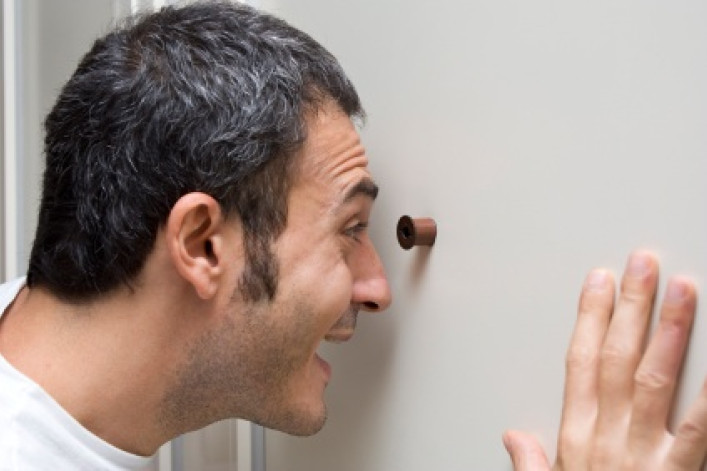How to Keep Bed Bugs Out of Your NYC Apartment

(Ed.'s note: This post was updated on 3/15/11.)
It's perfectly understandable for vertical dwellers to harbor a heightened fear of bed bugs.
The bloodfeeding insects travel across hallways, through walls and floors, and between storage bins; they can lurk in the laundry room; and they can hitchhike on the backpack of your daughter’s best friend down the hall.
And even if you are fastidious about avoiding flea markets or you regularly heat-treat your luggage after a business trip, you can’t force all your neighbors to, nor is there a totally foolproof way to keep bed bugs out of your bed once they're in the building.
There are some tactics to hedge your risk, however.
We found them with the help of pest management guru Gil Bloom, otherwise known as the entomologist behind Standard Pest Management, a member of the Mayor's former bed bug advisory board, and New York Magazine's 2011 pick for best bed bug exterminator.
Here's our action plan for keeping your neighbor's bed bugs out:
1. Know what steps your board or landlord should be taking if there is problem in your building
Renters: Your landlord must eradicate all bed bug infestations in your building, which means the infestations must be identified first. As recommended by the Bed Bug Advisory Report released by the city last year, landlords should inspect surrounding apartments for signs that the bugs have spread. Any apartment connected horizontally or vertically to an infested one should be checked, and so on, until reaching a unit that comes up "clean."
A landlord who fails to inspect apartments surrounding an infested one could be found liable in housing court for negligence, says real estate lawyer Steven Wagner of Wagner Berkow.
Owners: Co-op boards have the same responsibility as landlords to stop the spread to other apartments. Most condo bylaws require the same of their boards. Regardless of the minimal requirements, it’s smart for a board to proactively manage any level of bed bug infestation in order to preserve property values and prevent a much bigger clean up cost should the infestation get out of hand.
2. Defend your perimeter
On your own or with an exterminator (who may refer to the following measures as "exclusion services"), here are three things you can do to help stop your neighbor’s bedbugs from crossing into your space.
Dust: Apply diatomaceous earth dust in potential bed bug crawl spaces like the cracks and crevices in baseboards and moldings, around radiators where pipes come through, any place a service line (gas, electric, telephone, cable) enters your apartment, behind switch plates and electrical outlets etc. Some containers are actually squeeze bottles which enable you to “blow” the dust. (See this how-to video from BedBugCentral.com.)
(If you're renovating and the moldings are off, this is an excellent time to do some prophylactic dusting.)
When a bed bug crosses the barrier, the diatomaceous earth acts like razor wire, cutting open the insects' stomachs and exposing them to infection and dehydration. (A fitting end to a bloodthirsty pest?)
You can buy a one-pound bag of dust for about $15 online. (Look for “food” or “insecticide” grade, NOT “swimming pool” which can be dangerous if inhaled.) Some hardware stores and Home Depots may carry it, or you can buy it through the online or retail arms of a pest control company like Bloom's.
Seal: After you’ve dusted, seal up any cracks and gaps with SEALANT caulk (not regular caulk) purchased in the hardware store. (In some cases, an exterminator may recommend that you re-seal your wood floor too.)
Spray: You can spray along the perimeters of baseboards and moldings yourself with non-professional strength sprays. Bloom says most of the products available to the public have limited effectiveness, and may need to be reapplied weekly. Among the better ones, he says, is Bedlam, because it kills eggs as well as the actual bugs.
3. Install an early warning system
Early bed bug infestations—like a single hitchhiking insect you brought home from the movies last week or the two strays from 4C--are extremely difficult to catch.
So this next section of advice applies to EVERY bed bug paranoiac: If you are not infested yet, we predict you will sleep fairly soundly after taking the steps below. If you are infested, you will find out very shortly. And if you come down with bed bugs in the future, you will know it at a very early and treatable stage than you might otherwise.
First, place bed bug traps beneath your bed legs. You have a couple of choices here.
ClimbUp Insect Interceptor are white coaster-like plastic dishes that sit beneath your furniture legs and intercept bugs crawling in and out of your bed before or after feeding. The traps are lightly dusted with talc, which makes them too slippery to crawl out of, and they cost about $60 for a box of 12. (To see past the dust bunnies, you'll need to wipe them out every two to three months and re-dust with talcum powder.)
A brand new product called the Bed Bug Barrier ($6.99/each) uses glue to trap the bugs, and from what we can tell it’s a more aesthetically sensitive solution, though as Bedbugger.com points out, it may be more difficult to inspect these traps to see if you have a problem.
There are a couple of caveats. If bed bugs are already living in your bed, they probably won’t be trekking up and down the bed legs to eat you. Boxspring and mattress encasements (see this excellent primer on Bedbugger.com) are important to give the bugs fewer places to hide. Make sure the encasements you buy are certified as Bed Bug Proof.
Also beware of accidentally providing an alternate onramp for bed bugs: Keep blankets from touching the floor, and move your bed from away from the wall, the nightstand or other furniture.
Next, put out passive insect monitors in bedrooms. These work best in actively used bedrooms, as body heat and carbon dioxide from a human is necessary for baiting purposes.
The PackTite Passive Bed Bug Monitor ($19.95 online) is essentially a flat cardboard home for bed bugs with an adhesive on the back. Stick one near your bed, such as on the wall behind your headboard, and check it at least once a month for signs of fecal matter (bed bugs that have just fed like to relieve themselves just before sleeping it off).
Another passive monitor, the CatchMaster Bed Bug Detection System, takes a cardboard and glue approach and at about $65 for a box of 72 (more info here) is a less expensive option.
For extra insurance--perhaps if you are living right next door to an active infestation--you could also put out active bed bug monitors.
Placed on the floor near the head of your bed, the BB Alert Active Bed Bug Monitor ($24.95/ea) uses heat to attract bed bugs to its glue-trap interior. The downside is that the heat is generated by disposable pads ($30 for 24) that last 8-10 hours and need to be discarded after each use. The company's website recommends using the traps two or three nights a week, and notes that it will take a couple of weeks to detect an early infestation.
[Ed's update 3/7/12: If you see some dark little stains on your bedding or bed that may or may not be bed bug poop, there's a neat new product, Bed Bug Blue Fecal Spot Detection Kit , that will tell you for sure.]
4. Use caution in common areas
If there is a bed bug problem in your building, you will want to take some extra measures in the laundry room.
Avoid communal folding tables and make sure you get back downstairs to remove your laundry from the machine before someone puts your stuff on the table.
Bed bugs and their eggs can survive cold-water washes, so if you follow up an infested load with your own cold-water wash and then take something out to air dry, you could in theory be pulling out a live bed bug or egg along with it. To kill both bugs and eggs, dryers must be on high heat (122 degrees minimum) for about an hour.
If you have a storage bin, consider putting all your belongings in sealed plastic bags or airtight tubs to prevent cross migration from someone’s infested suitcase, for instance.
5. Think twice about socializing with your building buddies
If your building is infested, you may want to cut back on intra-building socializing for awhile, or at least take it to a neutral spot outside the building. Odds are your neighbors are feeling the same way.
If not, remember that bed bugs most like to travel in your stuff--backpacks, purses etc--rather than on your person, so keep your personal footprint to a minimum.
Related posts on BrickUnderground:
Top 10 bed bug products for New Yorkers
Finally, a breakthrough in bed bug detection
Bed bugs and lice in the laundry room
Bed bugs 101: Fumigation Demystified (sponsored)
How bed bugs spread through apartment buildings
Your kid's bed bugs: Back to school advice for the paranoid and merely cautious
Recommended websites for bed bug information:
Cornell University Integrated Pest Management Program
























